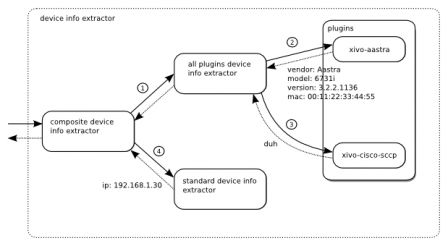HTTP/TFTP requests processing in provd - part 1
Well. Yes. provd ask a "device info extractor" object to extract information from the HTTP request, and that object returns the information we were expecting. But what is really happening inside that "device info extractor" ? Let's see:
The device info extractor object is in fact only merging results from two others device info extractor.
The "all plugins device info extractor" ask for each installed plugin to extract info from the request. In this case, the wazo-aastra plugin is of course able to extract a lot of information by looking at the User-Agent header, but the wazo-cisco-sccp plugin is of no help. The results are then merged and returned.
The "standard device info extractor" extract the IP address. Its role is to only extract basic information from requests.
From what we learned, we can deduce some properties of device information extraction in provd.
First, if no plugins are installed, only IP addresses will ever be extracted.
Next, we can ask ourselves what happens when two plugins returns different information. Well, the "all plugins device info extractor" is capable of applying different merge strategies. I won't go into more details for now.
The last thing we can see is that a bad plugin could make the system unreliable. You do not want to be in the situation were wrong information is extracted by a plugin. That is why it's always safer to only install the plugins you need, and no more.
Now that we know all that, let's see what happens for a request coming from a Cisco 7940. One of the first request it does is:
TFTP RRQ SEP554433221100.cnf.xmlTFTP requests are really simple, especially if you compare them to HTTP requests. The only interesting information an RRQ (read request) can have is the filename. But a filename can contain a lot of information.
TFTP requests take a similar flow as HTTP requests in provd. In our example, the wazo-aastra plugin will return no information from it, but the wazo-cisco-sccp plugin will be able to extract both the vendor and the MAC address. For this request, it's not possible to determine the model nor the firmware version.
So provd knows the request came from a Cisco, and that its MAC address is 55:44:33:22:11:00. That's not much, but it's better than nothing.
That said, there is a special trick for extracting information about the model on Cisco 7900 phones. I won't tell you what it is because I'm getting tired of writing this article, but all I can say is that it's pretty neat, and it's also useful in some other situation. Well okay, I'll just say the name: DHCP integration.
That's all folks. We have both seen the best (Aastra 6731i) and the worst (Cisco 7940) case concerning device info extraction in provd. That said, even the worst case doesn't pose a real problem. Next time, if I don't get too many death threat following this article, I'll talk about the next step of request processing in provd, device retrieving, which is quite simpler by the way.
